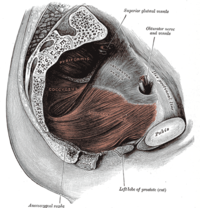Levator ani muscle
| Levator ani muscle |
|---|

|
| origin |
| Pubic bone , obturator fascia |
| approach |
| Anus, ligamentum anococcygeum |
| function |
| Elevation of the sacral flexure of the rectum during defecation |
| Innervation |
| direct fibers from the sacral plexus |
The levator ani muscle (lift of the anus) together with its fascia forms the pelvis diaphragm ( pelvic floor ). Comparatively anatomically, it belongs to the tail muscles .
Shares
The levator ani muscle can be divided into different parts:
- Pubococcygeus muscle
- Puborectalis muscle
- Iliococcygeus muscle
-
Musculus pubovaginalis (in women)
Musculus levator prostatae (in men)
function
The levator ani muscle is used to lift the anus during defecation . Its tone stabilizes the perineal flexure of the rectum and is therefore important for stool continence. In female individuals, the Mm. levatores ani on both sides also cover the vagina and allow this hollow organ to be narrowed at will. The levator ani muscle is also important for stabilizing the pelvic organs. In a relaxation (. For example as a result of births) there may be a fall ( descent ) or even an incident ( prolapse ) of the vagina (see vaginal prolapse ) and uterus (see uterine prolapse come). The likelihood of descensus and prolapse is greatly increased if the puborectalis is torn at the front of the pubic bone, which only happens in vaginal births, usually the first. The decensus can sometimes be counteracted through targeted pelvic floor training. If a muscle ruptures, however, the levator ani muscle is permanently weakened and, despite the frequency of a levator rupture (depending on the study, up to 30% of first-time mothers), there has been no scientifically recognized operation to restore function.
